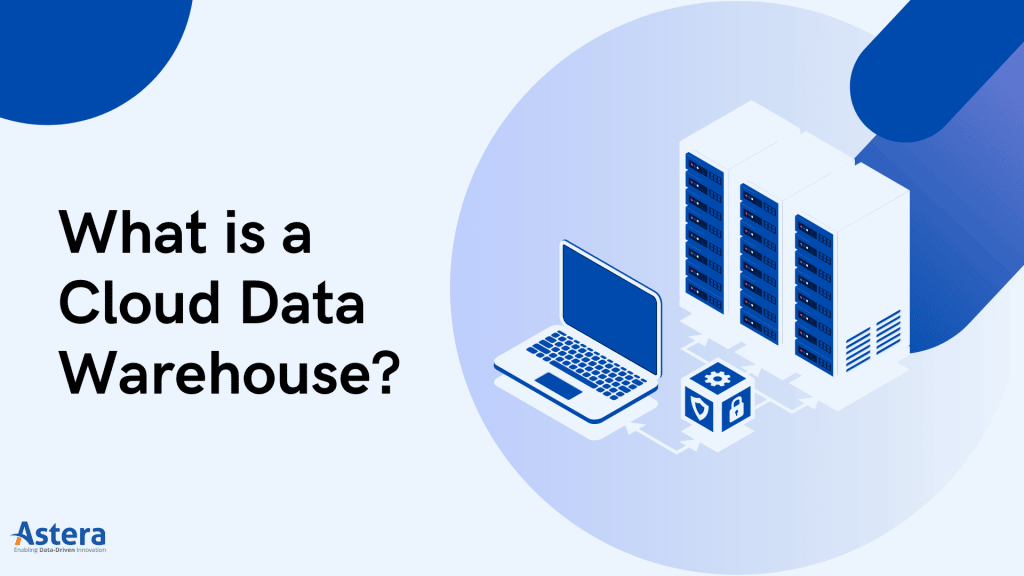
What is a Cloud Data Warehouse? A Complete Guide

What is a Cloud Data Warehouse?
Simply put, a cloud data warehouse is a data warehouse that exists in the cloud environment, capable of combining exabytes of data from multiple sources. Cloud data warehouses are designed to handle complex queries and are optimized for business intelligence (BI) and analytics. The benefits of a cloud data warehouse extend to breaking data silos, consolidating the data available in different applications, and identifying opportunities that would otherwise go unnoticed with a traditional on-premises data warehouse.
Cloud Data Warehouse Definition
A cloud data warehouse is a centralized database in a public cloud for storing, processing, integrating, and managing large volumes of structured and semi-structured data.
The “cloud” part means that instead of managing physical servers and infrastructure, everything happens in online — offsite servers take care of the heavy lifting, and you can access your data and analytics tools over the internet without the need for downloading or setting up any software or applications.
A cloud data warehouse is critical to make quick, data-driven decisions. It offers improved computational ability and simplified data management, allowing you to extract valuable insights from updated, accurate, and enriched data when needed.
Key Features of a Cloud Data Warehouse
There are certain key features inherent to a cloud data warehouse that position it as a valuable solution for businesses looking to benefit from the cloud. It offers the right balance of security, scalability, and accessibility, along with numerous other features. These include:
Performance: Quick and efficient querying of large datasets.
Integration: Seamless integration with various analytics tools.
Security: Strong measures like encryption and access controls.
Cost Management: Pay-as-you-go model for cost-effectiveness.
Scalability: Easily adjusts to data volume and processing needs.
Accessibility: Data access from anywhere with an internet connection.
Automatic Updates: Regular automatic updates for the latest features and security patches.
Practical Tips To Tackle Data Quality During Cloud Migration
The cloud offers a host of benefits that on-prem systems don’t. However, cloud migrations are not a straightforward journey. Here are some tips to ensure data quality when taking your data warehouse to the cloud.
Download Whitepaper
Cloud Data Warehouse vs. On Premises Data Warehouse
The traditional data warehouse architecture can no longer cope with the growing analytics needs of businesses today. The fact that the cloud data warehouse market is expected to reach $3.5 billion by 2025 only means that traditional, on-premises data warehouses have increasingly been unable to provide organizations with the speed, scalability, and agility they seek. The table below summarizes the difference between cloud data warehouse vs. on-premises data warehouse:
| On-Premises Data Warehouse | Cloud Data Warehouse | |
|---|---|---|
| Deployment | Deployed on physical servers on-site | Deployed on virtualized servers on the internet |
| Scalability | Offers limited scalability, requires upfront hardware investment | Easily scalable with on-demand resources adjustment |
| Maintenance | Requires in-house IT management for updates and troubleshooting | Managed services, less maintenance burden |
| Cost Structure | Involves capital expenditure (CapEx) with upfront costs for hardware and infrastructure | Operational expenditure (OpEx), pay-as-you-go pricing model offers flexibility and efficiency |
| Flexibility | Fixed capacity, harder to adapt to changing needs | Flexible, can scale resources based on demand |
| Integration | Limited integration with cloud services | Seamless integration with various cloud services |
| Accessibility | Limited accessibility, tied to physical location | Accessible from anywhere with an internet connection |
| Deployment Speed | Longer lead times for hardware procurement, setup, and configuration | Quick deployment with on-demand resources, reduced time-to-value |
| Updates and Upgrades | Manual updates and upgrades, potentially causing downtime | Automated updates, minimal downtime with managed services |
| Disaster Recovery | Relies on on-premises backup and recovery solutions | Built-in disaster recovery options in the cloud |
Cloud Data Warehouse Architecture
Cloud data warehouse architecture refers to the structural design and organization of components within a data warehouse that is hosted and managed in the cloud. It includes key elements and their interactions, ensuring efficient data processing, storage, integration, and retrieval. The following components make up the cloud data warehouse architecture:
Data Sources: The data sources refer to the diverse origins from which data is collected and ingested into the data warehouse for analysis. These sources can vary widely in terms of data types, formats, and delivery mechanisms, ranging from transactional databases to streaming data and external APIs. One of the biggest strengths of cloud data warehouses is their ability to handle diverse types of data, including structured, semi-structured, and unstructured data.
Data Ingestion Layer: The data journey in a cloud DWH begins with the data ingestion layer, which is responsible for seamlessly collecting and importing data. This layer often employs ETL processes to ensure that the data is transformed and formatted for optimal storage and analysis. Some cloud data warehouses support real-time data ingestion, allowing you to ingest and process data as it becomes available.
Storage Layer: The storage layer organizes and stores data in a structured format optimized for analytical processing. This format may involve columnar storage, which is well-suited for analytics due to its ability to compress and store similar data types together. The storage layer integrates with the compute layer for data retrieval based on the requirements of analytical queries. Many cloud data warehouses utilize distributed file systems for storage, distributing data across multiple nodes and providing scalability and parallelism.
Compute Layer: The compute layer is responsible for processing queries and performing analytical operations on the stored data. It manages the allocation of resources, such as CPU and memory, to different queries and workloads. Resource allocation is dynamic and can be adjusted based on the priority and requirements of the ongoing tasks.
Query Optimization and Execution: The compute layer incorporates query optimization techniques to improve efficiency. The cloud data warehouse’s engine optimizes SQL queries by choosing optimal execution plans, indexing strategies, and through other optimizations to minimize query response times. Many cloud data warehouses use cost-based optimization to parse queries. This approach evaluates different execution plans and selects the one with the lowest estimated cost.
Integration with BI Tools: Cloud data warehouses provide connectivity protocols and interfaces that allow seamless integration with BI tools. Common protocols include Java Database Connectivity (JDBC), Open Database Connectivity (ODBC), and RESTful APIs. These data warehouses also support Online Analytical Processing (OLAP) capabilities, allowing BI tools to create data cubes for multidimensional analysis. This is particularly valuable for complex analytical scenarios.
Design, develop, and deploy your data warehouse in the cloud
Building a data warehouse no longer requires coding. With Astera Data Warehouse Builder you can design a data warehouse and deploy it to the cloud without writing a single line of code.
Learn More
Benefits of Cloud Data Warehouse
Cloud data warehouses are easier to set up compared to their traditional counterparts, which generally entails a complex setup. A modern CDWH stores, integrates, and processes large volumes of data from several sources, whether on-premises or on the internet.
Here are more benefits of a cloud data warehouse:

Enhanced Accessibility
Data warehouses hosted on he cloud allow access to relevant data from anywhere in the world. What’s more, they come with access control features to ensure that the data required for BI is only visible to the relevant personnel. Interestingly, even though multiple employees may be accessing the data warehouse simultaneously, data integrity remains intact. The added layer of governance enhances the overall data quality management efforts of an organization.
Limitless Scalability
The virtual architecture enables organizations to modify their resource allocation according to changing demands. With a cloud data warehouse, companies with fluctuating needs have the option to pay only for the features and capabilities they need – something impossible with on-premises alternatives. For instance, tourism companies may need more computational power for enhanced analytics during the high season while it may only consume a fraction of this processing power during the low season.
Uncapped Performance
A cloud data warehouse allows all departments in an organization to access relevant data simultaneously without sacrificing performance. This is possible because they typically have multiple servers that share the load, ensuring that large amounts of data are processed simultaneously without any delays.
Abundant Data Storage
One of the most convincing reasons to opt for a cloud data warehouse is the excess amount of storage it offers. As mentioned earlier, cloud data warehousing solution providers often have a pay-as-you-go pricing model, which allows organizations to scale up or down without wasting storage space. The same also applies to other capabilities and features that allow businesses to experiment with data warehousing projects without incurring high costs.
Seamless Integration
According to a recent study, companies use data from over 400 sources for analytics and business intelligence. So, the data is not only in several different formats, but also structured in different ways, which makes integration difficult. Cloud data warehouses can help maneuver through the challenges of integration as they are designed to integrate data from multiple sources, including cloud applications, databases, and file formats. This structure also allows extraction and consolidation of semi-structured and unstructured data.
Disaster Recovery
Disaster recovery with legacy databases is often questionable. Companies using legacy tools must spend large amounts of money for additional hardware required to create data backups in case of a disaster or a system failure. A cloud data warehouse mitigates most of these problems by regularly creating backups, protecting important data in case of a disaster. Additionally, organizations adopting virtual solutions for their analytics avoid the unnecessary costs of purchasing equipment or storage areas to store their hardware.
Design a Cloud Data Warehouse From Scratch
With Astera Data Warehouse Builder, you can design purpose-built, cloud data warehouses from scratch within days. Sign up for a demo and see how it's done.
View Demo
Cloud Data Warehousing Challenges
While cloud data warehouses offer significant benefits, especially when it comes to scalability and flexibility, it has its own set of challenges and complexities.
Data Integration
Data integration challenges in the cloud are due to the diversity in data sources, the dynamic nature of the infrastructure, and the need to manage and govern data effectively. Additionally, organizations often have a mix of on-premises and cloud-based systems and integrating data between these systems can involve several additional considerations, including security, latency, and connectivity.
Security
The need to align encryption practices with specific organizational requirements can be complex due to the diverse data environments. For example, if your organization has a hybrid infrastructure, including on-premises and cloud-based systems, integrating encryption practices between them seamlessly can be challenging. Additionally, operating in multi-cloud environments requires access control standards that are compatible across different cloud platforms. Ensuring consistent access controls when data is distributed across multiple cloud providers requires standardization efforts.
Compliance
Cloud service providers operate on a shared responsibility model, where they manage certain aspects of security, but customers are responsible for others. Understanding and fulfilling this shared responsibility can be complex. The dynamic and diverse nature of regulatory landscapes, which often span industries and jurisdictions, can become a hurdle in ensuring compliance with regulatory bodies.
Cost Management
While cloud data warehouses offer unparalleled flexibility and on-demand resources, the pay-as-you-go model can lead to unexpected costs if not carefully monitored. The challenge lies in optimizing resource utilization to match variable workloads and data processing demands. It can be difficult to predict costs accurately, particularly when dealing with fluctuating data volumes and complex analytical queries. Additionally, the diverse range of services and features offered by cloud data warehouses can result in unintentional over-provisioning or underutilization, impacting cost efficiency.
Vendor Lock-In
Organizations leveraging the features and services of a specific cloud data warehouse solution provider risk becoming tightly integrated with that provider’s proprietary technologies and APIs. While these technologies enhance efficiency and functionality, they also create dependencies that can be challenging to unravel. Transitioning to a different cloud provider or adopting a multi-cloud strategy becomes complex, as the migration process may involve rewriting queries, adapting data models, and addressing compatibility issues.
Dimensional Modeling or Data Vault Modeling? We've got both!
Whether you're into Dimensional Modeling for intuitive analytics or Data Vault Modeling for agile scalability, we have you covered. Get the best of both worlds with Astera Data Warehouse Builder.
Download Trial
Best Cloud Data Warehouse Solutions for Businesses
Most cloud data warehousing solutions operate on the pay-as-you-go pricing model preferred by businesses, especially startups that are new to the world of data warehousing. This pricing option is also helpful for businesses that foresee new sources and platforms being added to their data architecture because a cloud data warehouse can evolve quickly to meet these needs.
Additionally, the most common cloud data warehouse solutions offer similar value when it comes to delivering high-performance, scalability, flexibility, ease-of-use, and pricing. What varies is how these are implemented. Organizations should carefully evaluate the unique features and strengths of each cloud data warehouse solution based on their specific requirements and preferences.
Cloud Data Warehouse: Microsoft Azure Synapse Analytics
Microsoft Azure Synapse Analytics combines big data analytics with enterprise data warehousing to accelerate time to insight. Specifically, it uses SQL for data warehousing, Spark technologies to handle big data, and Pipelines for data integration via ETL and ELT. Azure Synapse Analytics also integrates seamlessly with BI tools like Power BI.
It can be a viable data warehouse solution if your organization is involved in all, or most of, these data management endeavors. Additionally, if you already use multiple other Microsoft services, consider integrating Azure Synapse Analytics into your existing data stack since Microsoft’s services integrate smoothly together.
Use Azure Synapse Analytics for:
- Big data analytics
- Real-time analytics
- Serverless querying on data lakes
- Predictive analytics and forecasting
- Enterprise-grade cloud data warehousing
- Integrating advanced analytics and ML
Cloud Data Warehouse: Amazon Redshift
Amazon Redshift is a fully managed, petabyte-scale data warehouse service provided by Amazon Web Services (AWS). It is designed to handle large datasets and deliver high-performance analytics for organizations seeking a scalable and cost-effective solution. Amazon Redshift is particularly well-suited for analytical workloads and business intelligence applications.
Use Amazon Redshift for:
- BI and analytics
- Cloud data warehousing
- Ad-Hoc analysis
- Integration with AWS services
- Complex queries and aggregations
- Scalable data processing
Cloud Data Warehouse: Google BigQuery
Google BigQuery is a fully managed, serverless cloud data warehouse solution provided by Google Cloud Platform (GCP). It is designed to handle large-scale analytics workloads and enables you to analyze and query large datasets in real-time. Its integration with other Google cloud services makes it a comprehensive platform for various data analytics needs.
Use Google BigQuery for:
- Ad-hoc data analysis
- Real-time dashboards
- Log analytics
- IoT data analytics
- Predictive analytics
- Cloud data warehousing
Cloud Data Warehouse: Snowflake
Snowflake is a cloud-based data warehousing platform that provides a fully managed and scalable solution for storing and analyzing data. It operates as a Software-as-a-Service (SaaS) platform and is designed to be simple, flexible, and efficient for organizations seeking a modern cloud data warehouse.
Use Snowflake for:
- Cross-cloud data replication
- Data-intensive application development
- Company-wide data sharing
- Cybersecurity analytics
- Cloud data warehousing
- Enhanced data access
Dimensional Modeling or Data Vault Modeling? We've got both!
Whether you're into Dimensional Modeling for intuitive analytics or Data Vault Modeling for agile scalability, we have you covered. Get the best of both worlds with Astera Data Warehouse Builder.
Download Trial
Opting for a Cloud Data Warehouse: Factors to Consider
It’s crucial to consider several factors when selecting a cloud data warehouse solution for your organization. Here are some considerations you can take into account:
Ease of Use
When evaluating a cloud data warehouse, the simplicity and familiarity of the query language are paramount, particularly if your team is well-versed in SQL. A seamless transition is crucial for efficiency and productivity. Additionally, assess the solution’s integration capabilities with your current BI tools and data integration services. A cloud data warehouse that effortlessly fits into your existing technology and data stack ensures a cohesive and streamlined workflow and minimizes disruptions.
Performance
Assessing query performance, particularly for complex analytical queries, provides insights into the platform’s ability to handle your specific workloads effectively. Concurrent user and query handling capabilities are equally important, as a robust solution should be able to manage multiple simultaneous users and queries without compromising responsiveness. Scalability, both in terms of storage and compute resources, is an important consideration to ensure the solution can seamlessly grow with your evolving data demands.
Pricing
Evaluate the pricing structure to ensure it aligns with your usage patterns to avoid any unforeseen costs. Beyond per-query or per-GB pricing, assess the total cost of ownership (TCO) and remember to account for factors like storage costs and data transfer expenses. Taking the bigger picture into account will ensure that the chosen cloud data warehouse not only meets your immediate budgetary considerations but also proves economically sustainable in the long run.
Vendor Lock-in
Prioritizing multi-cloud support contributes to a resilient and adaptable data stack. Evaluate the cloud data warehouse solution’s capability to seamlessly deploy across multiple cloud providers, ensuring flexibility in choosing and transitioning between services. This not only mitigates the risks associated with dependence on a single vendor but also provides the ability to leverage the unique offerings of different cloud environments.
Vendor Support
A responsive and reliable vendor support system is crucial for timely issue resolution and ensuring that your team can leverage the full potential of the cloud data warehouse. Evaluate factors such as response times and the availability of support plans. Additionally, consider looking at the platform’s community engagement and the quality of available documentation, as these resources often prove invaluable in navigating challenges and optimizing usage.
How Astera Can Facilitate Your Move to the Cloud
Adopting a cloud data warehouse for your organization is a big decision. In addition to training and preparing your employees for the move, you’ll also have to ensure everyone involved in the migration process is well-versed in the intricacies of the selected platform, as well as the migration process itself.
This is exactly where Astera comes in with its Data Warehouse Builder—a unified, metadata-driven data warehouse solution. With Astera, you can:
- Build a full-fledged data warehouse from scratch in a matter of days, not weeks
- Deploy high-volume, fully operational data warehouses both on-premises and cloud
- Automate the data vault modeling process to create hubs, links, and satellites
- Connect to BI and analytics tools seamlessly for reporting and in-depth analyses
And much more—all without writing a single line of code.
Ready to leverage the benefits of a cloud data warehouse? Get in touch with one of our experts today. Alternatively, you can download a 14-day free trial or view demo.
 Astera AI Agent Builder Coming Soon
Astera AI Agent Builder Coming Soon


